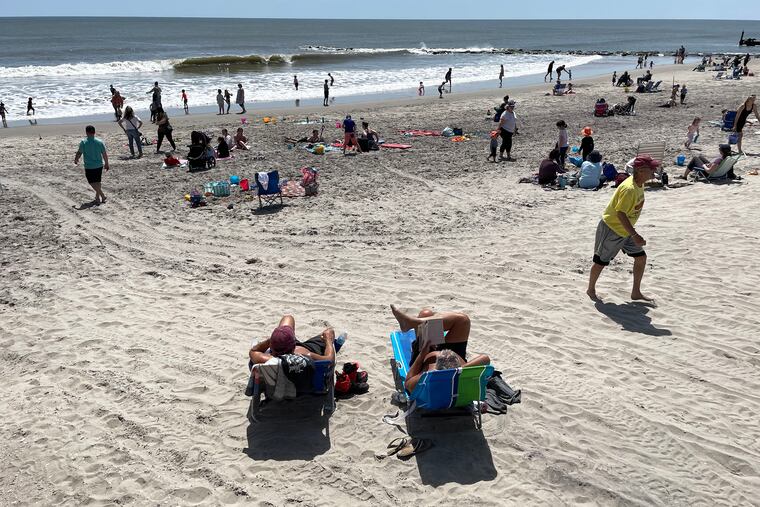The UV index around Philly this weekend may be about as high as it gets. Here’s what that means.
The great "beach umbrella" in the sky helps, but the sun will be as strong as it is in July.

Under that great “beach umbrella” in the sky, temperatures generally will be pleasant, but with the sun as strong as it will be in July, expect a near 100% chance that some folks are going to get a nasty sunburn during the Memorial Day weekend.
The Philadelphia region is approaching its annual peak season for that ultraviolet radiation that, along with the sting and indignity of sunburn, is associated with melanoma, cataracts, and assorted afflictions.
“It’s getting close,” said Laura Ciasto, a meteorologist with the government’s Climate Prediction Center who is responsible for those “UV index” forecasts that aim to capture the potential ultraviolet intensity. They are a National Weather Service-Environmental Protection Agency partnership.
» READ MORE: Melanoma rates have declined among young people
With clear skies expected Sunday at the Shore, the index could reach the “very high” levels of 9 or 10, forecasters say. The scale ranges from 0, which would be the South Pole about now, to 11-plus, the likes of Miami.
The forecasts are available daily on weather service and EPA sites and also are posted by commercial services such AccuWeather Inc. and the Weather Channel.
And while those index numbers seem simple enough, they are derived through a complex set of variables, not all of them pronounceable, says Ciasto, and they have quite a fascinating history with their roots in Australia’s “slip, slop, slap” campaign of four decades ago.
The process
Humans have several layers of protection from the sun, the grandest of which is the ozone layer — not to be confused with ground-level ozone that sets off air-quality alerts. The good stuff is nine to 18 miles in the stratosphere.
“It acts as Earth’s beach umbrella,” Ciasto said.
The forecast process begins with estimates of ozone levels, via satellites. Ozone concentrations vary and they are not all-shading. Just how much sun gets past that umbrella depends on factors that include cloud cover, time of day, time of season, latitude, and surface. All those go into the forecast equations.
(If you want to try the calculation at home, here is how it works.)
Temperature, by the way, is not a factor: One can get sunburned while skiing because snow reflects so much UV radiation. Sand also is a decent reflector.
Those numbers
At each increment of the scale, the EPA has recommended actions, with wearing sunglasses and limiting sun exposure during the peak sun hours as the leitmotifs.
» READ MORE: What to know about buying sunscreen
When the forecast levels are “high” — that is, 6 to 7, in the average range in summer for the Philly region — or “very high,” 8 to 10, the EPA advises covering up, using sunscreen, and being a glutton for shade.
At “extreme” levels, 11 and up, the agency warns that skin can burn “in minutes.”
Fair-skinned people are more vulnerable, but the government advises that people with darker skin also are “capable of burning.”
Twilight for tanning?
Well-tanned skin was once viewed as a sign of health and vitality, but its popularity has been fading.
» READ MORE: Study documents indoor tanning hazards
Research that identified the hazards of indoor tanning salons has hurt what was once a booming industry.
In the 1950s and ’60s tanning lotions were heavily advertised on radio, television, and billboards, not to mention purchased.
However, the Australians, who get more than their share of sun, began raising red flags about the health dangers, Ciasto said, when they noticed increased incidences of skin cancer.
Circa 1980, the nation’s Cancer Council, which calls Australia the “skin cancer capital of the world,” developed the “slip, slop, slap” campaign — as in slip on a shirt, slop on some sunscreen, and slap on a hat — credited with raising awareness of ultraviolet-radiation hazards.
The Australians, Ciasto said, “were very instrumental in educating the public to the harmful effects” of excessive sun exposure.
Eventually, researchers in Canada developed a UV index that became publicly available in 1992. The U.S. index debuted in 1994.
What are the peak sun hours?
The EPA recommends limiting sun exposure between 11 a.m. and 4 p.m., but that’s a guideline.
The sun’s power is at its maximum at solar noon, which is about 1 p.m. these days, and thus would be strong for a few hours on either side.
AccuWeather Inc. recommends this measuring stick: If your shadow is shorter than you, then chances are the UV levels are high.